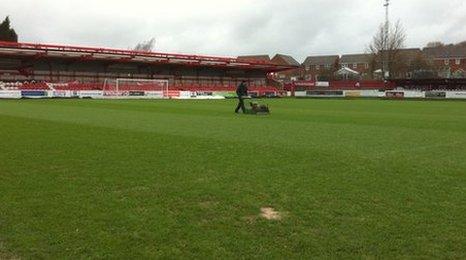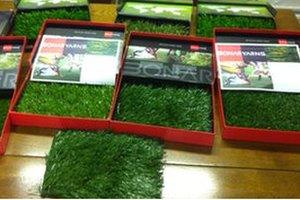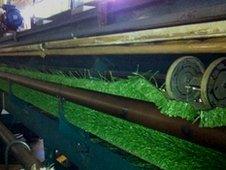Plastic pitches 'a step closer' at lower league clubs
- Published

The damage on Accrington's real pitch is more dangerous than a fake pitch
Patches of turf are missing and parts of the goal area look worn at Accrington.
The ground is typical of a lower league pitch in December after the frost and 25 games.
Accrington is one of a growing number of league clubs that want the option of installing a plastic pitch.
Newsbeat has found that for the first time at a league two meeting more than half the clubs said they would like the option of having a synthetic pitch.
The reason is simple: to save money and jobs.
"The fact is on maintenance alone, before relaying costs, we're paying £30,000 a year and we only get to use it maybe 35 times," says club chief executive Rob Heys.
No clubs in the football league have had a fake pitch since 1994 when Preston were the last side to reinstall grass.
New ones were banned in 1988 due to fears over injuries and uneven bounces.

Clubs can pick the colour, length and style of grass to mimic local grass
But things have changed.
The new plastic pitches are made with rubber padding and it is possible to personalise them to resemble local ground conditions.
Plastic surfaces have to meet Fifa quality tests but they are now used across Europe in top-flight leagues like Russia and Belgium.
In Scotland, four clubs in divisions two and three use them.
Any club wanting to install an artificial pitch would need the support of more than 50% of the 72 clubs in the football league.
Because of the amount of movement in the Championship, more than half of the clubs in that division must also agree.
'Identical bounce'
John Morrison is the managing director of Leigh Spinners which is one of the few companies that makes plastic pitches.
He says that developments in technology mean that players physically should feel no difference.

A plastic pitch costs up to £500,000 and lasts for about 10 years
"They are identical," he says. "The bounce of the ball is measured and the bounce should be between 60 and 90cm. That's what you get on natural turf and that's what you get on these."
Plastic pitches can cost up to £500,000 and can last for 10 years.
But it's the revenue that they could bring to clubs like Accrington and Wycombe that club officials see as important.
Players could train on the pitch, saving costs elsewhere, and they could also be used for concerts and other events without the worry of damaging expensive turf.
It would also create jobs.
Some of the fans in Accrington think it's a good idea too.
"[Real grass] is all right until December but then games start getting called off," says 18-year-old Gary Buchanan.
But others think it's not real football without the grass and are also worried about being laughed at.
Twenty-four-year-old Anton Stanley says: "You wouldn't see one at Manchester United, so why do we have to have one here?"